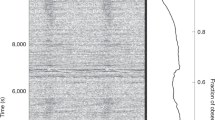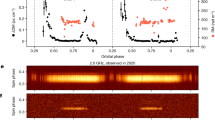Abstract
Recent observations1,2 at the Arecibo Observatory have resulted in the discovery of PSR1855+09, a pulsar with period P=5.362 ms, moving in a nearly circular orbit of period 12.3 days. The pulsar is only the third one known with P < 10 ms, and the sixth known radio pulsar in a binary system. (Discovery of a seventh binary pulsar is announced in an accompanying paper3.) Three of the seven binaries are among the fastest five of more than 400 pulsars—a fact that provides strong support for the conclusion that fast pulsars are ‘recycled’ neutron stars, spun up during a phase of mass accretion from an evolving companion star. The pulsar has a small dispersion measure (13.3 cm−3 pc), suggesting a distance of only ∼350 pc. The proximity of this pulsar and its location within 25 pc of the galactic plane argue that millisecond pulsars form a significant fraction (∼10%) of the pulsar population, leaving many detectable ones undiscovered4,5. Its signal is strong enough to permit pulse-arrival-time measurements with single-day uncertainties of <3µs. Timing observations already suggest that PSR1855+09, like the 1.5-ms pulsar PS R1937+21, will prove to be a natural clock of extremely high stability6. The existence of a second pulsar with extremely small timing uncertainties will greatly aid the search for background gravitational waves using millisecond pulsars as detectors.
This is a preview of subscription content, access via your institution
Access options
Subscribe to this journal
Receive 51 print issues and online access
$199.00 per year
only $3.90 per issue
Buy this article
- Purchase on Springer Link
- Instant access to full article PDF
Prices may be subject to local taxes which are calculated during checkout
Similar content being viewed by others
References
Segelstein, D. J. thesis, Princeton Univ. (1986).
Segelstein, D. J., Taylor, J. H., Rawley, L. A., Stinebring, D. R. : Wolszczan, A. IAU Circ. No. 4262 (1986).
Dewey, R. J., Maguire, C. M., Rawley, L. A., Stokes, G. H. & Taylor, J. H. Nature 322, 712–714 (1986).
Stokes, G. H., Segelstein, D. J., Taylor, J. H. & Dewey, R. J. Astrophys. J. (submitted).
Bhattacharya, D. & Srinivasan, G. Curr. Sci. 55, 327–330 (1986).
Davis, M. M., Taylor, J. H., Weisberg, J. M. & Backer, D. C. Nature 315, 547–550 (1985).
Rawley, L. A., Taylor, J. H. & Davis, M. M. Nature 319, 383–384 (1986).
Bartel, N. et al. Astr. J. 90, 318–325 (1985).
Backer, D. C., Fomalont, E. B., Goss, W. M., Taylor, J. H. & Weisberg, J. M. Astr. J. 90, 2275–2280 (1985).
van den Heuvel, E. P. J. J. Astrophys. Astr. 5, 209–233 (1984).
van den Heuvel, E. P. J., van Paradijs, J. & Taam, R. E. Nature 322, 153–155 (1986).
Stinebring, D. R. Nature 302, 690–692 (1983).
Backer, D. C. & Rankin, J. M. Astrophys. J. Suppl. Ser. 42, 143–173 (1980).
Stinebring, D. R., Cordes, J. M., Weisberg, J. M., Rankin, J. M. & Boriakoff, V. Astrophys. J. Suppl Ser. 55, 247–277 (1984).
Radhakrishnan, V. & Cooke, D. J. Astrophys. Lett. 3, 225–229 (1969).
Manchester, R. N. & Taylor, J. H. Pulsars, 218 (Freeman, San Francisco, 1977).
Hankins, T. H. & Cordes, J. M. Astrophys. J. 249, 241–253 (1981).
Narayan, R. & Vivekanand, M. Astrophys. J. 274, 771–775 (1983).
Narayan, R. & Vivekanand, M. Astr. Astrophys. 122, 45–53 (1983).
Barnard, J. Astrophys. J. (in the press).
Gil, J. Astrophys. J. 299, 154–160 (1985).
Kulkarni, S.R. Astrophys. J. 306, L85–L89 (1986).
Wright, G. A. & Loh, E. D. Nature (in the press).
Author information
Authors and Affiliations
Rights and permissions
About this article
Cite this article
Segelstein, D., Rawley, L., Stinebring, D. et al. New millisecond pulsar in a binary system. Nature 322, 714–717 (1986). https://doi.org/10.1038/322714a0
Received:
Accepted:
Issue Date:
DOI: https://doi.org/10.1038/322714a0
This article is cited by
-
Millisecond Pulsars, their Evolution and Applications
Journal of Astrophysics and Astronomy (2017)
-
Millisecond pulsar searches
Il Nuovo Cimento C (1990)
-
Pulsar observations with the «Northern Cross»
Il Nuovo Cimento C (1990)
Comments
By submitting a comment you agree to abide by our Terms and Community Guidelines. If you find something abusive or that does not comply with our terms or guidelines please flag it as inappropriate.



